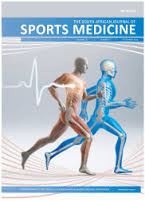Association of the acute:chronic workload ratio and wellness scores in premier league male hockey players
DOI:
https://doi.org/10.17159/2078-516X/2021/v33i1a9244Abstract
Background: The relationship between acute:chronic workload ratios (ACWR) and the incidence of injury, as well as the relationship between subjective wellness scores and training load, is unclear in hockey players.
Objectives: This study investigated these relationships to determine if the ACWR is a useful workload management tool for field hockey players. In addition, the study investigated the association between specific subjective wellness scores (fatigue, sleep quality, general muscle soreness, mood and stress level) and the acute:chronic workload ratio and training load. The study also assessed the association between individual players’ training loads with the self-reported wellness scores.
Methods: Fourteen male field hockey players from the men’s first team at the University of the Witwatersrand participated in the study over ten weeks during a premier league competition phase. A Google form was completed within thirty minutes of every training session/match. This form consisted of questions that allowed for the calculation of the ACWR.
Results: No incidence of injury was reported during the ten- week period. ACWR scores ranged between 0.67 and 1.87. The ACWR was associated with general muscle soreness (p = 0.010) and training load was associated with fatigue (p = 0.002), sleep quality (p = 0.05), general muscle soreness (p = 0.004), and mood (p=0.025).
Conclusion: There may be some merit in the use of subjective wellness measures as workload management tools in field hockey. Further research is required to determine if there is an optimal ACWR for this sport.
Downloads
Downloads
Published
Issue
Section
License
Copyright (c) 2021 South African Journal of Sports Medicine

This work is licensed under a Creative Commons Attribution 4.0 International License.
The South African Journal of Sports Medicine reserves copyright of the material published. The work is licensed under a Creative Commons Attribution 4.0 (CC BY 4.0) International License. Material submitted for publication in the South African Journal of Sports Medicine is accepted provided it has not been published elsewhere. The South African Journal of Sports Medicine does not hold itself responsible for statements made by the authors.
How to Cite
- Abstract 410
- PDF 443






.png)